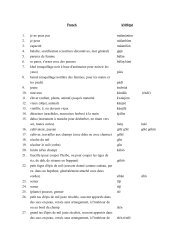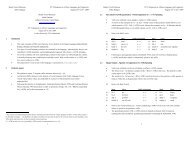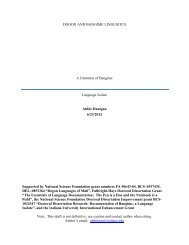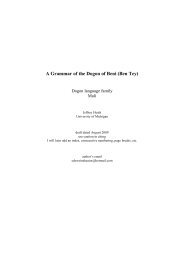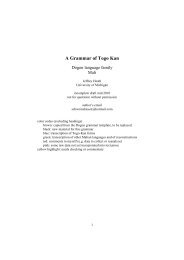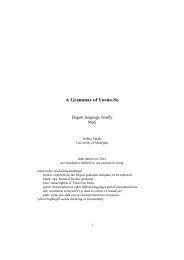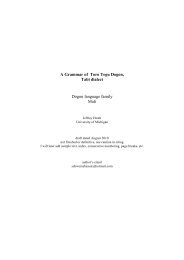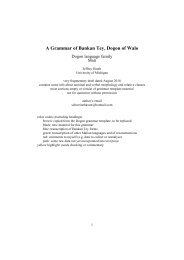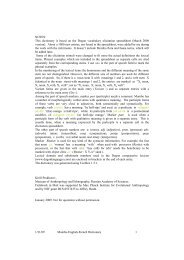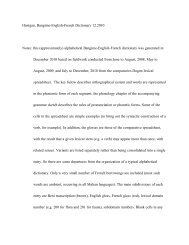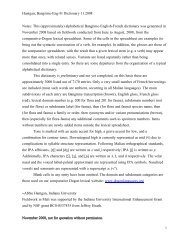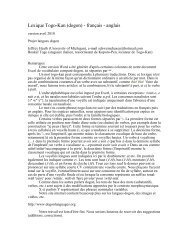- Page 1 and 2: A Grammar of MomboSongho DialectDog
- Page 3 and 4: Contents3.2.2 Metrical structure of
- Page 5 and 6: 6.3.3.1 Adjective sequences 1036.3.
- Page 7 and 8: 10.2.3.2 Experiential Negative -té
- Page 9 and 10: 13.1.7 Focalization of postposition
- Page 11 and 12: (xx2)bɛĺíhókkòanimal pen‘ani
- Page 13 and 14: To argue that the distinction betwe
- Page 15: experiential perfect + + e/ɛVN in
- Page 22 and 23: 4.1 Nominal, pronominal, and adject
- Page 24 and 25: (xx7) a. {HL} stem, high-toned PL m
- Page 26 and 27: ‘Fulani people’s house’ (pún
- Page 28 and 29: a low tone by contrast to the tone
- Page 30 and 31: ‘hyena’ tâ: tá:-gè/*‘grass
- Page 32 and 33: ɛ̀mbɛ̀dúlúmá ‘corn’ ɛ̀
- Page 34 and 35: As mentioned above, alongside ńdá
- Page 36 and 37: gédé-gédé‘clitoris’b. {HL}g
- Page 38 and 39: dóŋgò ‘emotional center associ
- Page 40 and 41: gyé ‘steal’ - - gyí-ŋgà ‘
- Page 42 and 43: nólò ‘friend’ nóló-ŋgè
- Page 44 and 45: 4.3.4 Effector nominalsVerb stems c
- Page 46 and 47: Unlike other Dogon languages Mombo
- Page 48 and 49: 1SG-with work do.IPFV-PROSP.1SG‘I
- Page 50 and 51: pronouns in most of the cases. This
- Page 52 and 53: gún-yɛ̂: kwàsay-MP.PFV EMPH‘I
- Page 54 and 55: {A: ‘Where is X? B: ‘He went to
- Page 56 and 57: loci that òló:ⁿ refers to, it b
- Page 58 and 59: In (xx1) identificational clitic -w
- Page 60 and 61: ‘(the) donkey is lazy’Syntactic
- Page 62 and 63: However, when these function as a p
- Page 64 and 65: 4.6.7 Iterated (fully reduplicated)
- Page 66 and 67:
‘40’ dɛ̂:‘50’ dɛ̀:-ndó
- Page 68 and 69:
4.8.2.2 Other ordinals (suffix -xxx
- Page 70 and 71:
(xx.d) ámárù débú kándà (1 2
- Page 72 and 73:
(xx1) that has numeral tá:ndì ‘
- Page 74 and 75:
numeral tà:ndì remain with head,
- Page 76 and 77:
6.1.3 Internal bracketing and tone-
- Page 78 and 79:
noun bǒy ‘key’ changes tone co
- Page 80 and 81:
(xxx) [[séydù wé:-gè] kúléy
- Page 82 and 83:
(xx3) ámárù nɛ́:A. hand.H‘Am
- Page 84 and 85:
(xx3)tone classtone contour when po
- Page 86 and 87:
wèlè-wéléyà:lè-yá:lá‘Apus
- Page 88 and 89:
kándà in (xx3) has more than two
- Page 90 and 91:
Noun + demonstraive sequences can h
- Page 92 and 93:
upper.place person-PL‘upper peopl
- Page 94 and 95:
6.2.2 Pronominal possessionPronomin
- Page 96 and 97:
(xx7)a. long vowel, high tonegloss
- Page 98 and 99:
6.2.2.2 Alienable possessive constr
- Page 100 and 101:
(xx1) ǹ-yɔ̌:-gè nɛ́:ŋgá1SG-
- Page 102 and 103:
6.2.3 Recursive possessionIn this s
- Page 104 and 105:
(xx1) [[sàrí ɲɛ̂:] ábúlò]qu
- Page 106 and 107:
The recursive possession patterns p
- Page 108 and 109:
6.3.2 gámúgè ‘certain (ones)
- Page 110 and 111:
As the term suggests, the function
- Page 112 and 113:
(xxx) dèbù wɛŕɛ́dɛ́ kírí-
- Page 114 and 115:
‘hot/fast’ ná:gá bálú-bál
- Page 116 and 117:
The main evidence comes from the to
- Page 118 and 119:
(xxx) [house.L big.L] new]Then, the
- Page 120 and 121:
examplesa complication is that this
- Page 122 and 123:
intrinsic tone, or atonal (getting
- Page 124 and 125:
(xx3a) Séydù ńdô: á: ńdô: à
- Page 126 and 127:
'Every time, (there was) one sheep
- Page 128 and 129:
Note that in this construction the
- Page 130 and 131:
9 Verbal derivationA standard list
- Page 132 and 133:
yɔ̀: yɛńà dúzé / * dúzú-r
- Page 134 and 135:
As will be discussed later some Mom
- Page 136 and 137:
input gloss reversive glossbáŋg-y
- Page 138 and 139:
markers functions. Unlike the other
- Page 140 and 141:
(xx4) List or derivatives in -rVI a
- Page 142 and 143:
(xx6) báyérè ‘add, help’díg
- Page 144 and 145:
ɲámí ‘(apparatus) be kaput’
- Page 146 and 147:
A few verbs with stem vowel /ɔ/ ha
- Page 148 and 149:
Formally the two tonal classes of q
- Page 150 and 151:
esult of resyllabification. See §
- Page 152 and 153:
9.3.4.1 Causative ndVIn one case kn
- Page 154 and 155:
gógóje ‘chew on (bone)’kábá
- Page 156 and 157:
productive on the set of active ver
- Page 158 and 159:
dú:-yá‐mì/ dú:-rá-mì 3b ‘
- Page 160 and 161:
9.4 BenefactiveIn addition to causa
- Page 162 and 163:
After the syncope of the stem final
- Page 164 and 165:
utter be.melted‘Butter is melted
- Page 166 and 167:
9.5.3 -yV/-yV: with stative verb st
- Page 168 and 169:
examples known to me are given in (
- Page 170 and 171:
númbyê: ‘rub in (oil, lotion)
- Page 172 and 173:
yá:gá ‘pretty, beautiful’ yá
- Page 174 and 175:
d. mɔǵɛ́ ‘wash clothes’mɔ
- Page 176 and 177:
I.2 Experiential PerfectSeries 1 m
- Page 178 and 179:
1SGǹ-sɛ̀mà-té:ⁿyè ‘I have
- Page 180 and 181:
- Series 3 3PROSP (§ 10xxx)- Serie
- Page 182 and 183:
As argued in §3.2.x the 3SG simple
- Page 184 and 185:
I.1 final /o/bó: ‘be (copula)’
- Page 186 and 187:
V. Imperative PL màlyà-yⁿ màly
- Page 188 and 189:
VNCV and CVNCV stems are phonologic
- Page 190 and 191:
Tri- and quadrisyllabic stems that
- Page 192 and 193:
púgújèpúrúdyê:sáyélèsáyé
- Page 194 and 195:
In a narrative the perfective fulfi
- Page 196 and 197:
1Sg -xxx- -xxx-1Pl -xxx- -xxx-2Sg -
- Page 198 and 199:
10.2.1.5Recent Perfect (-jE-)Mombo
- Page 200 and 201:
3Sg/Inan3Pl-xxx-xxxexamples10.2.2.2
- Page 202 and 203:
The name of her town was Biot.Both
- Page 204 and 205:
(xx1)gloss PFV (3SG) PFV.NEG (3SG)A
- Page 206 and 207:
e a case of stem homonymy. Historic
- Page 208 and 209:
10.3.3Vowel-semivowel interactions
- Page 210 and 211:
3Sg -xxx xxx3Pl -xxx xxx10.6Post-ve
- Page 212 and 213:
special 3Pl form?examples‘Long ag
- Page 214 and 215:
gloss SG PLslaughtersɛḿá sɛḿ
- Page 216 and 217:
Negative Hortative (NH) has a meani
- Page 218 and 219:
(xx3) Prohibitive (bimoraic bisylla
- Page 220 and 221:
10 VERBAL INFLECTION...............
- Page 222 and 223:
One can consider this as an evidenc
- Page 224 and 225:
as a part of that class, since thei
- Page 226 and 227:
The animacy don't necessary presupp
- Page 228 and 229:
(xx3) It is usually attaches to nou
- Page 230 and 231:
11.1.6 NEED-verbsIn Mombo, meanings
- Page 232 and 233:
truth 1SG-OBL tell.IMP.HL‘Tell me
- Page 234 and 235:
ámárù ìnjɛ̀ yɛńà-ⁿ Séyd
- Page 236 and 237:
'he died for his family'(xx11)dèb
- Page 238 and 239:
wálé kání 'do work' kání ‘d
- Page 240 and 241:
dɔźí dɔźɛ́ ‘forge (tools)
- Page 242 and 243:
I'm aware of three cases, in which
- Page 244 and 245:
(xx1)gloss N N+it.is'goat' úná ú
- Page 246 and 247:
(xx2)nɛ̂: mí=wóthis 1SG-it.is
- Page 248 and 249:
- sentential complements(xx1)ò-by
- Page 250 and 251:
ádù ò-dígá / *dì-dígápromis
- Page 252 and 253:
mì: bâ: ɔ̀jɛ̀-ndá túlá gâ
- Page 254 and 255:
(xx1)déní gé nɛ́:ŋgà wánjé
- Page 256 and 257:
he has become a woman’(xx1)ámsá
- Page 258 and 259:
used with Existential particle?11.2
- Page 260 and 261:
11.3 Quotative verb11.3.1‘Say’
- Page 262 and 263:
The H tone is imposed:[Séydú déb
- Page 264 and 265:
11.4.1Positive adjectival predicate
- Page 266 and 267:
(xx1)ànnà ɲɛ́-ẁⁿ‘the she
- Page 268 and 269:
13 Focalization and interrogation13
- Page 270 and 271:
The second feature, found the both
- Page 272 and 273:
13.1.3 Relative markedness of focus
- Page 274 and 275:
'who cried?'wɔ̀ á: wé:'who crie
- Page 276 and 277:
‘It’s he who was here’yá:gù
- Page 278 and 279:
‘It’s to you-Sg [focus] that I
- Page 280 and 281:
form of ‘who?’ word (relationsh
- Page 282 and 283:
‘How much sugar did you buy?’
- Page 284:
264



